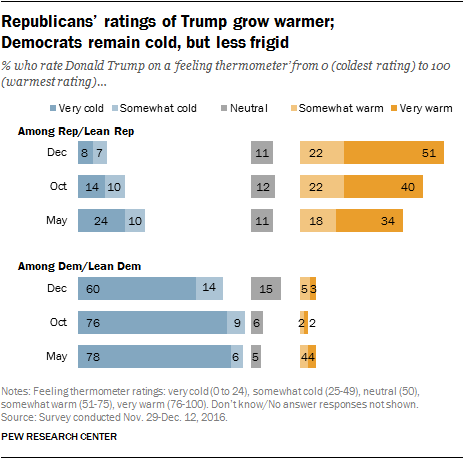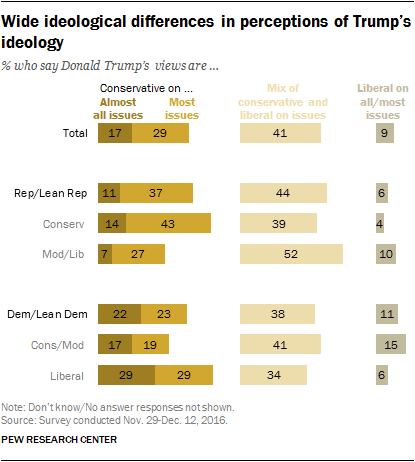After an extraordinarily negative campaign, with low personal marks for both Trump and Clinton throughout, Americans’ views of the two major candidates have improved slightly since the election.
Shortly before securing the nomination, about six-in-ten Americans registered “cold” feelings toward Donald Trump on a 0-100 degree “feeling thermometer” – where 0 is the coldest, most negative rating and 100 represents the warmest, most positive rating. At that time more than half (53%) gave him a very cold rating (a rating of less than 25 degrees), while an additional 8% gave him a “somewhat cold” rating (25 to 49 degrees). Just 28% gave him a warm rating (above 50 degrees).
Views of Trump were little changed as of early October. But following his victory, Americans’ ratings of Trump have thawed somewhat, though more continue to rate him coolly than warmly. Today, about half (48%) give Trump a cold rating, while 36% rate him warmly.
Throughout the campaign, Clinton was viewed somewhat more warmly than Trump, and today slightly fewer give her cold ratings than did so before the election. As a result, Trump’s current ratings are nearly identical to Clinton’s.
Among Republicans and Republican leaners, views of Trump improved from the primaries, through the general election campaign and again following his win. Today, nearly three-quarters of Republicans (73%), rate him warmly, including half (51%) who give him a very warm rating (76-100). The share of Republicans rating him coolly is now just 15%; in May, about twice as many Republicans (34%) gave Trump a cold rating.
In particular, Trump’s rating among Republicans who supported another GOP candidate during the primaries has warmed considerably: Just 30% rated him warmly in May, and 56% did so in October, while 69% do so today. Among Trump’s primary backers nearly all (96%) rate him warmly today, little different than the share who did so throughout the year.
Three-quarters of Democrats and Democratic leaners (75%) now rate Trump coldly, including fully 60% who rate him very coldly. Still, fewer now give Trump a cold rating than did so during the campaign.
Mike Pence viewed warmly by Republicans
Americans have mixed views of the vice president-elect. As Mike Pence prepares to enter office, 30% of Americans rate him warmly, while a roughly comparable share (33%) feels “cold” toward him; 15% rate Pence neutrally and an additional 22% say they can’t give him a rating.
Republicans, in particular, view Pence warmly: 61% give him a warm rating (including 47% who rate Pence very warmly). Democrats’ ratings of Pence are generally cold: 54% view him coldly, while 16% give him a neutral rating and just 6% rate him warmly (24% do not offer a rating).
 Speaker of the House Paul Ryan’s ratings are, on balance, less warm than Pence’s. About a third of the public (34%) feels coldly toward him, while just 20% feel warmly. Though the two GOP figures are both viewed coldly by most Democrats who rate them, Republicans feel far more warmly toward Pence than Ryan; just 38% of Republicans give Ryan a warm rating.
Speaker of the House Paul Ryan’s ratings are, on balance, less warm than Pence’s. About a third of the public (34%) feels coldly toward him, while just 20% feel warmly. Though the two GOP figures are both viewed coldly by most Democrats who rate them, Republicans feel far more warmly toward Pence than Ryan; just 38% of Republicans give Ryan a warm rating.
Perhaps unsurprisingly, Republicans’ ratings of Pence are closely related to feelings about Trump. The small share (15%) of Republicans who have cold feelings toward Trump also are more likely than other Republicans to have cold feelings toward Pence.
But Republicans’ views of Ryan are much less strongly related to their feelings about Trump. Republicans who give Trump a cold rating are about equally likely to give Ryan a cold (32%) as a warm (30%) rating.
Public continues to have mixed views of Trump’s ideological positions
As was the case during the campaign, Americans are fairly divided in their assessments of Trump’s ideological views: While 46% characterize his views as conservative on all (17%) or most (29%) issues, 41% say Trump’s views are a mix of liberal and conservative positions. Just 9% say he has all or mostly liberal views on issues.
There are only modest partisan differences in these perceptions, with Democrats and Democratic leaners somewhat more likely to say Trump’s views are almost all conservative (22% vs. 11% of Republicans and Republican-leaning independents).
But among Republicans, conservatives (57%) are far more likely than moderates and liberals (34%) to characterize Trump’s views as conservative, while moderate and liberal Republicans are more likely to call Trump’s views a mix of liberal and conservative positions (52% say this).
Among Democrats, the opposite pattern is evident: 58% of liberal Democrats and Democratic-leaning independents say Trump’s views on issues are all (29%) or mostly (29%) conservative. Among moderate and conservative Democrats, a far smaller share (36%) say this.
The tendency to view Trump’s ideology in relation to one’s own is particularly apparent when contrasting how the overwhelming majority (77%) of conservative Republicans who have warm feelings toward Trump differ in their ideological descriptions of him from the smaller set of conservative Republicans (23%) who have neutral or cold views of Trump. About two-thirds (66%) of conservative Republicans with warm views of Trump say that he has conservative views on most or almost all issues. But among the minority of conservative Republicans who do not hold warm views of Donald Trump, just 26% say that he holds almost all or mostly conservative issue positions.
Views of partisans, candidates’ supporters
Public views of “people who voted for Donald Trump” and of “Republicans” are largely comparable, but greater shares of the public rate Trump voters on the extreme ends of the feeling thermometer – both very warm and very cold – than do the same for Republicans. Slightly larger shares of the public give Trump voters very cold ratings (less than 25 on the 100 point scale) than they do Republicans (29% and 23% respectively). At the same time, Trump voters are more likely to receive very warm ratings: 30% give Trump voters a rating above 75, while just 21% give Republicans a similar rating.
In particular, Republicans and Republican leaners give Trump supporters warmer ratings than their fellow Republicans. About six-in-ten Republicans and Republican leaners (61%) give Trump voters very warm ratings, but when asked to rate their fellow Republicans, just 38% give similarly high ratings.
In contrast, Democrats and Democratic leaners express colder feelings toward Trump voters than they do Republicans in general. Nearly half (48%) give Trump voters very cold ratings, while 38% give Republicans a very cold rating.
The public is slightly warmer in their assessments of Clinton voters compared to Democrats in general. Nearly one third (32%) give Clinton voters a very warm rating, but only about a quarter (24%) give Democrats a similarly high rating.
Republicans give Clinton voters and Democrats roughly similar ratings. There are no significant differences between Republicans’ ratings of the two groups.
Though Democrats overwhelmingly give both Democrats and Clinton voters warm ratings, they are substantially more likely to rate Clinton voters very warmly than to give Democrats a top rating. About half of Democrats and Democratic-leaning independents (52%) give Clinton voters very warm ratings, while 37% of Democrats and Democratic leaners gave Democrats a similarly high rating.


